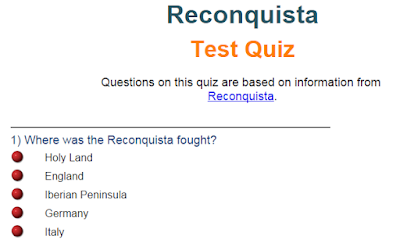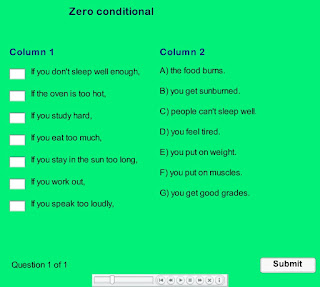REVISION
Wednesday, 20 November 2019
Unit 2 - The Moneran kingdom and the viruses
THE MONERAN KINGDOM
Monerans are unicellular living things. This kingdom includes bacteria, the most abundant of all living things.
BACTERIA
Bacteria are the smallest and simplest living things, and can only be seen through a microscope.
Most bacteria feed on other organisms, but some bacteria make their own food.
Bacteria can be foound everywhere in the world. They can live in all kinds of evnironments: in water, soil, air or inside other living things.
Some bacteria are helpful, like the ones used to make yoghurt, but other are harmful, like the ones that cuase cholera.
VIRUSES
Viruses are not included in any of the five kingdoms because they are not considered living things.
They cannot perform vital functions (nutrition, interaction, reproduction) on their own. A virus is not a cell. It is a microscopic body that can only reproduce inside living things. Viruses may cause illnesses (influenza gripe, measles sarampión, chicken pox varicela etc.)
Unit 2 - The Protista kingdom
THE PROTISTA KINGDOM
Protists include two very different types of organisms: algae and protozoa.
ALGAE
Algae are aquatic living things that can be unicellular or multicellular. They can make their own food (autotrophs). Some multicellular marine algae can grow to a very large size.
Algae are very nutritious, so they are used as food in many countries. They are also used as fertilizer and to produce cosmetics.
PROTOZOA
Protozoa are unicellular living things that live in aquatic environments. They feed on other organisms. Somo protozoa can cause diseases, like malaria.
Unit 2 - Fungi kingdom
THE FUNGI KINGDOM
Wild mushrooms are living things that grow on forest floors, tree trunks and even on top of each other. They need moist, cool temperatures and some light. Here it is one mushroom you can find in one of the trees of our school, amazing!! isn't it?
Which living thing can you see in this lemon?
Which kingdom does it belong to?
Is this living thing unicellular or multicellular?
Which kingdom does it belong to?
Is this living thing unicellular or multicellular?
Friday, 15 November 2019
Wednesday, 13 November 2019
What was the Reconquista?
THE RECONQUISTA
When the Muslims created al-Andalus, many Christians moved to the mountains in the north. Here was where Visigoth noble Pelayo defeated the Muslims in Battle of Covadonga in 722 A.D. and the Reconquista began.
After that, Don Pelayo established the Kingdom of Asturias. Later on this kingdom became the Kingdom of León. There were other Christian kigdoms too, such as the Kingdoms of Castilla, Navarra and Aragón.
 |
| Statue of Don Pelayo in Covadonga (Asturias) |
From the 8th and the 15th centuries, the Christian kingdoms expanded in to the south. They conquered lands from al-Andalus. This process is called the Reconquista.
Christians wanted to conquer al-Andalus for three reasons:
- The Christian kings needed more land for growing crops, raising animals and because the population was increasing.
- The Christians kings thought the lands of al-Andalus should be ruled by Christians, as in the times of the Christians Visigoths.
- After al-Andalus was divided into small taifa kingdoms, it was easier to conquer them.
During this time, despite the fights for the Reconquista, Muslims, Christians and Jews lived together and established a rich excange between cultures.
Alfonso VI was King of Castilla and León. In 1085 he conquered Toledo from the Muslims. It was a very important victory for the Christian armies because Toledo was a strategic area and a symbol of Christianity from the time of Visigoths.
 |
| Alfonso VI conquered Toledo, 25th may 1085. Banco de la Plaza de España de Sevilla |
In 1212 the Christians won the Battle of Navas de Tolosa in Jaén.
 |
| El Llibre del Fets. Autobiographical chronicles of James I The Conqueror.
Fernado III was King of Castilla y León. He conquered Córdoba in 1236 and Sevilla in 1248.
|
 |
| Fernando III, King of Castilla and León. |
Granada was the last Muslim Kingdom in the Iberian Peninsula. In 1492 king Fernando II of Aragón and Isabel I of Castilla, known as the Catholic Monarchs, conquered Granada. The Christian Reconquest was completed.
In the following picture we can see King Boabdil surrenders the Kingdom of Granada to the Catholic Monarchs.
 | |
| La Rendición de Granada by F. Pradilla (1882). This picture is found in the Palacio del Senado (Madrid). |
Click on the image below and you'll know the main characters of the Fall of Granada.
Here you have a famous Spanish TV serie where you can see this important event in the History of Spain.
Sunday, 10 November 2019
What was life like in al-Andalus?
SOCIETY IN AL-ANDALUS
After conquering the Iberian territories, the Muslims were tolerant of the previous inhabitants and respectful of their beliefs. They allowed them to continue practicing their religions and customs. Have a look to the following diagram below and answer the questions.
- How many different religions coexisted in al-Andalus?
- What social groups had to pay taxes?
- Why do you think some Mozarabs converted to the Muslim religion?
- What were the differences between Muladi and Mozarabs?
AN ANDALUSI CITY
- Which buildings were important? What were they used for?
- Can you see any of these types of buildings in your town today? If not, do you know any city where we can find them?
Unit 2 - Vertebrate animals
MAMMALS
An unusual mammal
The platypus is unique. It is a small, semi-aquatic mammal that lays eggs! When the females are going to have babies, they hide in burrows. There, they lay up to three eggs that hatch about ten days later. Platypuses are mammals, so the babies drink their mother’s milk.
Platypuses look like beavers. Their body and tail are covered with brown, waterproof fur that keeps them warm in cold water. They have four webbed feet and a duck-like bill with no teeth.
Platypuses are originally from Australia, and they live on land. They walk and run and can dig with the long nails they have on each foot. They are excellent swimmers and spend lots of time in streams and rivers. They eat small aquatic animals, such as worms, insect larvae and shrimps. They have a very sensitive bill that helps them feel for food on riverbeds.
Friday, 8 November 2019
Monday, 4 November 2019
Unit 2 - Zero conditional
Live curious
If you are, you breathe
If you breathe, you talk
If you talk, you ask
If you ask, you think
If you think, you search
If you search, you experience
If you experience, you learn
If you learn, you grow
If you grow, you wish
If you wish, you find
If you find, you doubt
If you doubt, you question
If you question, you understand
And if you understand, you know
If you know, you want to know more
Subscribe to:
Posts (Atom)



























